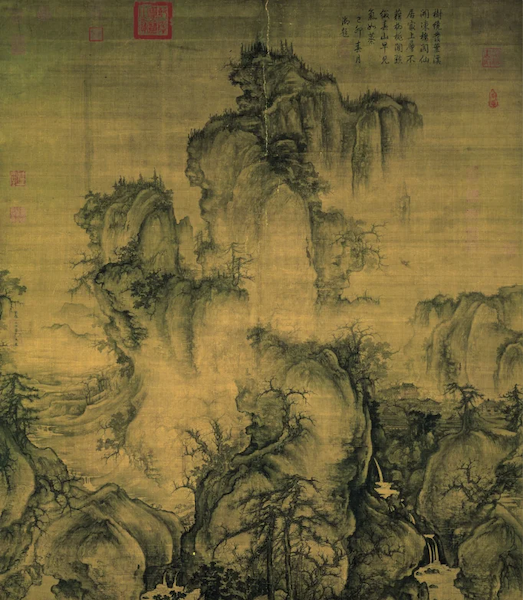
Mountains and Rivers of the Human Body
The Chinese saw the universe as unfolding from the Unity of the Dao into the multiplicity of diverse processes and objects that we see around us. This unfolding was understood and expressed through various organizing principles including Yin and Yang, the Five Phases (“Five Elements”), and the trigrams and hexagrams of the Yijing, among others. These universal patterns were seen as operating throughout nature, at all scales, so the idea of macrocosmic and microcosmic correlation was natural. As above, so below.
This so-called “correlative cosmology” lead way to the idea that the human body is a miniature cosmos, because indeed, the patterns of natural expression found in the universe at large would also express themselves on smaller scales such as a mountain landscape, and then again on even smaller scales such a human being. We are each a personal universe.
It’s no surprise then that the Huangdi Neijing 黄帝内经, the most important ancient source text for Chinese medicine, describes the human body as a complex ecological system, much akin to the natural world that the Chinese observed around them. In the same way that a healthy natural ecosystem maintains itself through a system of self-reinforcing checks and balances, a human body too maintains equilibrium when nothing is lacking or in excess. Blocking a major river can drastically affect the entire ecosystem, just as blocked blood and energy flow within the body can lead to health problems for an individual.
The Chinese represented this balance and harmony in their famous landscape paintings. Each element of the natural world was present with the yielding Yin elements (water, mists, tree foliage) balanced with the un-yielding Yang elements (rocks, trees). Motion and stillness are present throughout, reinforcing each other.
In the same way that regions of land can be separated into watersheds, so too can the human body, according to Chinese medicine: lesser yin, reverting yin, greater yin, lesser yang, yang illumination, greater yang. With the rivers of the human landscape expressed by various natural patterns of the flow of Qi and blood–the meridian system of the body. These are named according to what pattern and type of “river” they are:
Jing 经 – axial, running up and down, communicating the energy flows between Heaven and Earth.
Jing Luo 经絡 – a “luo” is a net or web. These are radial patterns flowing from the up/down Jing (the main river beds) out to the skin.
Jing Mai 经脈 – if there is blood running through it, it is called “Jing Mai” a “blood river.”
These correspondences between the human being and nature were mapped out more broadly and in detail in such classics as the Yi Jing 易经 (Book of Changes). Based on this ancient source text, systems of internal practice (neigong 内功), such as the Yijinjing, were naturally drawn from this understanding of the “unity of man and nature” (tian ren he yi 天人合一). Systems of Yijinjing often utilize 12 postures which map to the twelve organ-meridians in the human body which are in turn mapped to the 12 months in a year. Considering the left-right symmetry of the 12 meridians we actually have 24 which represent the twenty-four solar terms. Classically, there were a total of 365 xuewei 穴位 (acupuncture points) that existed on the meridians, as there are 365 days in a year. Yijinjing movements sometimes target key points that help to promote healthy qi flow and expel unhealthy qi stagnation. In this way it can be said that the Yijinjing is like the Yijing of the human body. A system of practice taking into account the natural rhythms and correspondences of nature that are found all around us and within us, at all scales.
Daoist art also made use of this idea of “body as cosmos” (or mountain landscape) symbolism in famous diagrams such as the Neijing Tu 內经图 in which the various energetic features and locals in the body, such as the microcosmic orbit (小周天), the elixir fields (Dantian 丹田), etc., which are important in alchemical cultivation (neidan 內丹) are depicted as a dynamic landscape.
In addition to mountain landscapes, it is interesting to note that the Daoists had several other models of symbolic representation that were commonly used, often with overlap. Some of these included the body as an administrative system that paralleled the bureaucratic systems of state on Earth and in the various celestial realms, as well as the body as an abode for a pantheon of deities residing in various organs and other locales. In the image below, from the Daoist scripture called Inner Meaning of the Wondrous Scripture of the Upper Chapters on Salvation (度人上品妙经内义) the human body is depicted as a mountain and includes the three Dantian as well as the Three Barriers (san guan 三关)–well known locals along the Du Meridian that must be “opened” to progress in Daoist alchemical practice. Also visible are several palaces of inner deities. This is important because it demonstrates that various models of symbolic representation are not in conflict with each other, but can co-exist simultaneously.
